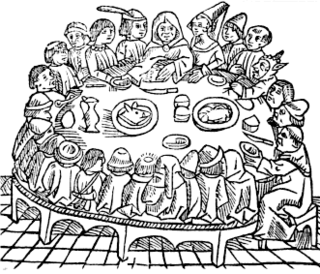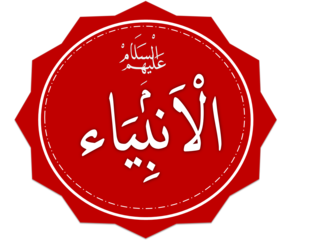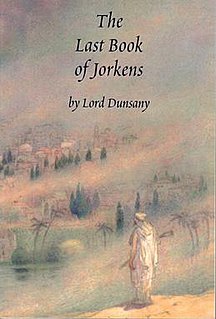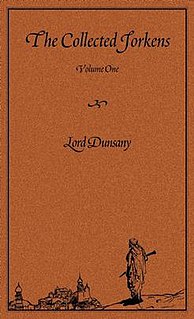A dilemma story (also dilemma tale) is an African story-form intended to provoke discussion. They are used as a form of both entertainment and instruction. [1]
A dilemma story (also dilemma tale) is an African story-form intended to provoke discussion. They are used as a form of both entertainment and instruction. [1]

The Canterbury Tales is a collection of 24 stories that runs to over 17,000 lines written in Middle English by Geoffrey Chaucer between 1387 and 1400. In 1386, Chaucer became Controller of Customs and Justice of Peace and, in 1389, Clerk of the King's work. It was during these years that Chaucer began working on his most famous text, The Canterbury Tales. The tales are presented as part of a story-telling contest by a group of pilgrims as they travel together from London to Canterbury to visit the shrine of Saint Thomas Becket at Canterbury Cathedral. The prize for this contest is a free meal at the Tabard Inn at Southwark on their return.

Fable is a literary genre: a succinct fictional story, in prose or verse, that features animals, legendary creatures, plants, inanimate objects, or forces of nature that are anthropomorphized, and that illustrates or leads to a particular moral lesson, which may at the end be added explicitly as a pithy maxim or saying.

A short story is a piece of prose fiction that typically can be read in one sitting and focuses on a self-contained incident or series of linked incidents, with the intent of evoking a "single effect" or mood, however there are many exceptions to this.

One Thousand and One Nights is a collection of Middle Eastern folk tales compiled in Arabic during the Islamic Golden Age. It is often known in English as the Arabian Nights, from the first English-language edition, which rendered the title as The Arabian Nights' Entertainment.

A fairy tale, wonder tale, magic tale, or Märchen is an instance of a folklore genre that takes the form of a short story. Such stories typically feature entities such as dwarfs, dragons, elves, fairies, giants, gnomes, goblins, griffins, mermaids, talking animals, trolls, unicorns, or witches, and usually magic or enchantments. In most cultures, there is no clear line separating myth from folk or fairy tale; all these together form the literature of preliterate societies. Fairy tales may be distinguished from other folk narratives such as legends and explicit moral tales, including beast fables. The term is mainly used for stories with origins in European tradition and, at least in recent centuries, mostly relates to children's literature.
Anansi is an Akan folktale character. He often takes the shape of a spider and is considered to be the god of all knowledge of stories. Taking the role of trickster, he is also one of the most important characters of West African, African American and Caribbean folklore.

Captain Blood: His Odyssey is an adventure novel by Rafael Sabatini, originally published in 1922.

The culture in Africa is varied and manifold, consisting of a mixture of countries with various tribes that each have their own unique characteristic from the continent of Africa. It is a product of the diverse populations that today inhabit the continent of Africa and the African Diaspora. African culture is expressed in its arts and crafts, folklore and religion, clothing, cuisine, music and languages. Expressions of culture are abundant within Africa, with large amounts of cultural diversity being found not only across different countries but also within single countries. Even though African cultures are widely diverse, they are also, when closely studied, seen to have many similarities; for example, the morals they uphold, their love and respect for their culture as well as the strong respect they hold for the aged and the important, i.e. kings and chiefs.
The hedgehog's dilemma, or sometimes the porcupine dilemma, is a metaphor about the challenges of human intimacy. It describes a situation in which a group of hedgehogs seek to move close to one another to share heat during cold weather. They must remain apart, however, as they cannot avoid hurting one another with their sharp spines. Though they all share the intention of a close reciprocal relationship, this may not occur, for reasons they cannot avoid.

The Qaṣas al-'Anbiyā' or Stories of the Prophets is any of various collections of stories adapted from the Quran and other Islamic literature, closely related to exegesis of the Qur'an. One of the best-known is a work composed by the Persian author Abū Ishāq Ibrāhīm bin Mansūr bin Khalaf of Neyshābūr the 12th century ; another was composed by Muhammad al-Kisai in the 8th century ; others include the Ara'is al-Majalis by al-Tha'alabi and the Qisas al-Anbiya by Ibn Kathir. The narrations within the Qisas Al-Anbiya, are not about historical accuracy, but rather about wisdom and moral teachings.
Tolkien's legendarium is the body of J. R. R. Tolkien's mythopoeic writing that forms the background to his The Lord of the Rings, a high fantasy novel which is widely considered to be his magnum opus. Tolkien worked and re-worked the components of his legendarium throughout his adult life, a period of more than 50 years; the earliest drafts, published in The Book of Lost Tales (1983), date to 1916, with poems, paintings and nomenclature related to it going back to 1914.

"The Owl and the Ape" is a fantasy story by American writer L. Sprague de Camp, part of his Pusadian series. It was first published in the magazine Imagination: Stories of Science and Fantasy for November, 1951, and first appeared in book form in the de Camp's collection The Tritonian Ring and Other Pusadian Tales. The story has also appeared in the anthology Kingdoms of Sorcery (1976). and the de Camp omnibus collection Lest Darkness Fall/Rogue Queen/The Tritonian Ring and Other Pusadian Tales (2014). It has also been translated into German.
African-American folktales are the storytelling and oral history of African American slaves during the 1700-1900s. Many are unique to the African-American culture, while others are influenced by African, European, and Native American tales.

The Last Book of Jorkens is a collection of fantasy short stories around the character Joseph Jorkens by writer Lord Dunsany. First prepared for publication in early 1957, it was left unpublished on Dunsany's death later that year, and was finally issued in a limited first special edition only in 2002, and become widely available on its inclusion in the later omnibus edition The Collected Jorkens, Volume Three, issued by Night Shade Books in April, 2005.
William R. Bascom (1912–1981) was an American folklorist, anthropologist, and museum director.

Wizard of the Crow is a 2006 novel written by Ngũgĩ wa Thiong'o and translated from the original Kikuyu into English by the author, his first novel in more than 20 years. The story is set in the imaginary Free Republic of Aburĩria, autocratically governed by one man, known only as the Ruler. The novel received the 2008 Tähtifantasia Award for the best foreign fantasy novel released in Finland in 2007.

Br'er Rabbit, also spelled Bre'r Rabbit or Brer Rabbit, is a central figure as Uncle Remus tells stories of the Southern United States. Br'er Rabbit is a trickster who succeeds by his wits rather than by brawn, provoking authority figures and bending social mores as he sees fit. The character was first recorded by Joel Chandler Harris in the 19th century, and later The Walt Disney Company adapted it for its 1946 animated motion picture Song of the South.

The Collected Jorkens is a three-volume omnibus collection of fantasy short stories by author Lord Dunsany and issued by Night Shade Books, then of Portland, Oregon.

"Judgment Day" is an apocalyptic science fiction story by American writer L. Sprague de Camp. It was first published in the magazine Astounding Science Fiction for August, 1955, and first appeared in book form in the anthology The Best Science Fiction Stories and Novels: 1956. It later appeared in the de Camp collections A Gun for Dinosaur and Other Imaginative Tales, and The Best of L. Sprague de Camp, as well as the anthologies Great Science-Fiction, A Science Fiction Argosy, and Masters of Darkness III. The story has also been translated into German.
The Ana people, also known as the Atakpame people, are an ethnic group of Benin and Togo. The Ana are concentrated between Atakpame, primarily in the Gnagna and Djama quarters, as well as between Atakpame and Sokode and down to the Togo-Benin border. Ethnologists identify the Ana as the most western of the Yoruba subgroups. In fact, the Ana trace their origins to Ife, and their dialect is also called Ife, which has about 210,000 speakers.
| This psychology-related article is a stub. You can help Wikipedia by expanding it. |